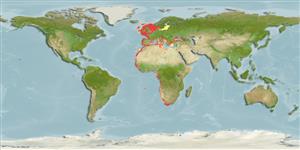分類 / Names
共通名の | 類義語 | Catalog of Fishes(部類, 種) | ITIS | CoL | WoRMS | Cloffa
Environment: milieu / climate zone / depth range / distribution range
生態学
海; 汽水性の; 海洋回遊性 (Ref. 51243); 深さの範囲 0 - 400 m (Ref. 2683). Subtropical; 62°N - 37°S, 18°W - 42°E (Ref. 54230)
Eastern Atlantic: Bergen, Norway to East London, South Africa (perhaps reaching Durban) (Ref. 10000). Also all of Mediterranean, Black and Azov seas, with stray individuals in Suez Canal and Gulf of Suez; also recorded from St. Helena (Ref. 189). Reported from Estonia (Ref. 33247).
Length at first maturity / サイズ / 重さ / 年齢
Maturity: Lm 10.1, range 9 - 14 cm
Max length : 20.0 cm SL オス/雌雄の選別がない; (Ref. 189); common length : 13.5 cm SL オス/雌雄の選別がない; (Ref. 189); 最大公表体重: 0.00 g; 最大記録サイズ: 5 年 (Ref. 92145)
背面の脊椎 (合計) : 0; 背鰭 (合計) : 16 - 18; 肛門の骨: 0; 臀鰭: 13 - 15; 脊つい: 46 - 47. Snout pointed; maxilla short, tip blunt, reaching almost to front border of pre-operculum, not projecting beyond tip of second supra-maxilla; tip of lower jaw reaching almost to below nostril. Gill rakers present on hind face of third epibranchial. Pseudobranch longer than eye, reaching onto inner face of operculum. A silver stripe along flank, disappearing with age.
Mainly oceanic, marine species, forming large schools (see Ref. 126017:598). Tolerates salinities of 5-41 ppt and in some areas, enters lagoons, estuaries and lakes, especially during spawning. Tends to move further north and into surface waters in summer, retreating and descending in winter. Feeds on planktonic organisms. Spawns from April to November with peaks usually in the warmest months. Eggs are ellipsoidal to oval, floating in the upper 50 m and hatching in 24-65 hours. Marketed fresh, dried, smoked, canned and frozen; made into fish meal (Ref. 9987).
Pelagic spawners. Gametogenesis is continuous, multiple spawning. Spawning peaks are usually in the warmer months which makes this species a spring-summer spawner. The limits of the spawning season is dependent on temperature and is therefore more restricted in northern areas. Sex ratio: 45% female (Ref. 5580).
Whitehead, P.J.P., G.J. Nelson and T. Wongratana, 1988. FAO Species Catalogue. Vol. 7. Clupeoid fishes of the world (Suborder Clupeoidei). An annotated and illustrated catalogue of the herrings, sardines, pilchards, sprats, shads, anchovies and wolf-herrings. FAO Fish. Synop. 125(7/2):305-579. Rome: FAO. (Ref. 189)
Human uses
水産業: 高い商業の; 餌: usually
用具
特記事項
XMLをダウンロードして下さい
インターネットの情報源
Estimates based on models
Preferred temperature (Ref.
123201): 7.1 - 18, mean 10.8 °C (based on 667 cells).
Phylogenetic diversity index (Ref.
82804): PD
50 = 0.5020 [Uniqueness, from 0.5 = low to 2.0 = high].
Bayesian length-weight: a=0.00468 (0.00423 - 0.00518), b=3.10 (3.07 - 3.13), in cm total length, based on LWR estimates for this species (Ref.
93245).
栄養段階 (Ref.
69278): 3.1 ±0.36 se; based on food items.
Generation time: 2.0 (1.6 - 2.8) years. Estimated as median ln(3)/K based on 47
growth studies.
回復力 (Ref.
120179): 手段, 1.4年~4.4年の倍増期間の最小個体群 (K=0.3-1.73; tmax=6; Fec =13,000-503,000).
Prior r = 0.59, 95% CL = 0.39 - 0.89, Based on 21 full stock assessments.
Fishing Vulnerability (Ref.
59153): Low to moderate vulnerability (29 of 100).
Climate Vulnerability (Ref.
125649): Low vulnerability (9 of 100).
Nutrients (Ref.
124155): Calcium = 170 [78, 369] mg/100g; Iron = 1.21 [0.63, 2.85] mg/100g; Protein = 18.7 [17.6, 20.0] %; Omega3 = 0.976 [0.611, 1.574] g/100g; Selenium = 19.1 [9.3, 36.9] μg/100g; VitaminA = 15.5 [4.4, 51.5] μg/100g; Zinc = 1.24 [0.79, 1.84] mg/100g (wet weight); based on
nutrient studies.
